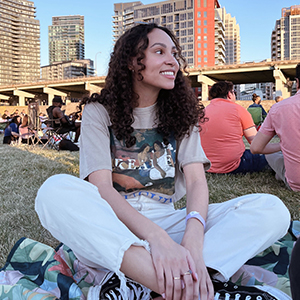
A statue of Egerton Ryerson has been vandalized once again in the wake of a recent discovery of 215 children’s remains by Tk’emlúps te Secwépemc First Nation at a former residential school in Kamloops, B.C. (just one confirmed of many such suspected sites).
The statue has long been seen as a monument to colonialism and genocide, as Ryerson was one of the early supporters of the residential school system and believed that they were integral to assimilating Indigenous children. Many people are calling for the statue to be taken down, and for Ryerson University to be renamed. Currently, ‘X University’ is being used by those refraining to call the school by the historical figure’s name, and the university’s journalism school has taken things a step further by renaming its publications to remove any reference to him.
Solemn night at X (Ryerson) University, named after an architect of Canada’s residential schools. Folks are sitting here until 215 shoes have been placed. About 115 now. Come down—intersection of Gould and Bond in Toronto. pic.twitter.com/SesbUeUngy
— Colleen Derkatch (@ColleenDerkatch) June 1, 2021
The news out of Kamloops this weekend shows why many of us at @RyersonU have decided to use “X University” in our signatures and social media bios. Theres no way to reconcile Egerton Ryerson’s legacy with healing or decolonization. Take the statue down. Change the name.
— Damien (@damienlee) May 31, 2021
The discovery of the 215 children has reignited necessary and long-overdue conversations around Canada’s ongoing legacy of colonization, and the work that still needs to be done toward Truth and Reconciliation for Indigenous peoples. “Dig them up” was written in paint across the statue after a sit-in, as calls grow for a deeper look into unmarked graves at other residential school sites.
It’s not just statues of Ryerson that are furthering the discussion around decolonization. Other landmarks that serve as traumatic reminders of racism and colonialism have been discussed, as people question whether Canadians should keep the names of the settler leaders such as Sir John A. Macdonald attached to schools, public transit systems and more.
Related: 10 young Indigenous women leading the way for the next generation.
I grew up in Kingston, ON, which is situated on Anishinaabe, Haudenosaunee and the Huron-Wendat lands. The city is known as being the home of Macdonald, the first prime minister, and Canada’s first capital. It is a place where his legacy is omnipresent; his presence looms large and his actions run deep. His home, Bellevue House, is a heritage site and museum. There are numerous statues, murals and plaques of him throughout the city. He has a public school named after him. The list goes on. In elementary and high school, I was inundated with information about him being the first prime minister and the father of Confederation, but the history of Indigenous peoples was largely glossed over, with no mention of them in the city. This curriculum was very intentionally designed this way. We did not learn about how it was his government that introduced residential schools in 1883, or any other of his racist policies including the Chinese Head Tax.
Over the years, there have been protests calling for the removal of one of the statues of him that resides in City Park. It has been toppled, egged, spray-painted, you name it. Instead of removing it, last year, the city installed security cameras around it. Kingston’s mayor, Bryan Paterson, told Global News that the community did not want the statue down, and added that they would be re-writing the plaques to more accurately reflect the history. “We are going to talk about both the good and the bad in Macdonald’s legacy and I think that’s how you find a way forward on such a divisive, controversial issue like this,” he said.
Related: 10 accidental microaggressions you might be making everyday.
Statues of Macdonald and other colonial leaders are painful reminders of how Indigenous people have been and continue to be treated in this country. Some people think these monuments must be removed in order to stop promoting these historical figures:
Can you imagine schools and other government buildings being named after Hitler or Mussolini? Me neither. So why is it ok here? Remove their names from buildings and put their statues in museums, detailing the full truth about their legacy.
— NLRM (@MrsNiki_) June 2, 2021
Others think taking them down isn’t a solution:
Here’s my take on cancel culture and removing statues. You removed John A, now what? This didn’t change poverty on reserves, this didn’t bring us clean drinking water or mental health services. This is only causing a further divide and is not the right step in reconcilation.
— Melissa Mbarki (@MelissaMbarki) June 2, 2021
The Truth and Reconciliation Commission has identified more than 4,100 children who died while attending a residential school. Given that the residential school system forcibly took Indigenous children away from their families, and subjected them to cultural erasure, starvation, and abuse, keeping these statues around signals to me that we’re supportive of the leaders who orchestrated this systemic oppression and blatant racism that persists to this day. But simply being upset about these monuments isn’t enough. Canadians need to learn about their history through Indigenous-centred learning as there cannot be reconciliation without acknowledging how the past has shaped the present. There needs to be action taken to support residential school survivors. The following groups and organizations are places to start:
- Indian Residential Schools Survivors Society
- Reconciliation Canada
- The Orange Shirt Society
- First Nations Health Authority
- Legacy of Hope Foundation
- ON Project Canada
- Indspire
If you are a residential school survivor and in need of support, please contact the National Indian Residential School Crisis Line at 1-866-925-4419 or the Hope for Wellness Helpline at 1-855-242-3310.


